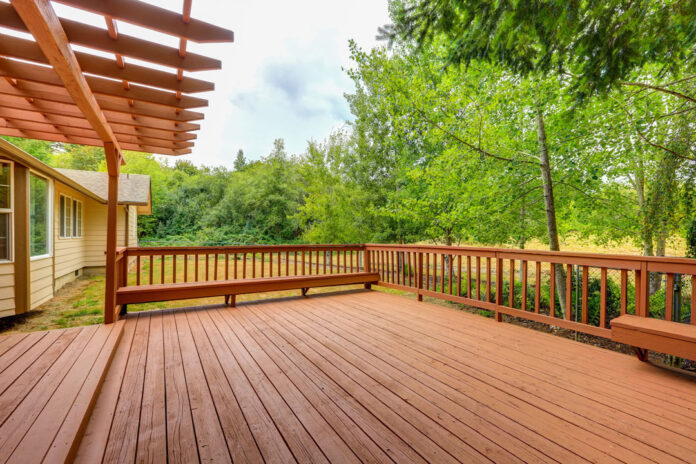Sanding a deck is a crucial part of the home improvement process. However, it can also be tedious and time-consuming if you don’t know what you’re doing. If you don’t have the right tools or know how to do it, it can lead to several issues that cause your deck to look less than desirable.
You may think that sanding a deck is a big job, and if you aren’t careful, you might create more problems than you solve. Here are some of the most common issues people run into when sanding a deck and how to solve them.
Issues and Solutions Related to Sanding a Deck
-
Not using the right tools
The first step in sanding your deck is using the correct tools. You need to ensure that you have set the correct pressure and speed settings on your sander or orbital sander. You also need to make sure that you’re using the right sandpaper.
Also, when sanding a deck, use 60- to 80-grit sandpaper on your power sander. To ensure stains and sealers penetrate the wood, use coarse-grit sandpaper instead of fine-grit sandpaper. This will prevent the pores from clogging up.
If you have no prior experience with this type of work and are unsure of what tools to use, it is best to do research, watch YouTube videos, or hire someone to do it for you.
-
Sanding your deck without first drying it
Most decks will require a thorough cleaning before being sanded. The most efficient way to do this is by using a power washer or pressure washer. You can also use soap and water with a sponge if you do not have access to either of these tools.
Once you have cleaned the surface of your deck thoroughly, you need to let it dry completely before sanding. If you do not allow your deck to dry completely, the moisture may cause problems while you are working on it. This may include warping or cracking in certain areas of your deck surface.
-
Using incompatible products
Some products are designed to work with standard decking lumber, and others are designed specifically for composite or hardwood. If the two types of products are mixed, they may not bond well or may even damage each other.
The most effective way to avoid this problem is by using only one type of product on your deck. For example, if you’re using an oil-based product on a tropical hardwood deck and then washing it off with water, you are almost certain to have some problems.
It can be problematic to use oily tropical hardwoods with water because the finish will appear to remain tacky and wet for an extended period of time. Due to the antioxidants in the heartwood, the finish will not cure properly (through oxidation). Make sure all your finished products use the same solvent base when sanding a deck to avoid this problem.
-
Insufficient sanding or coating
When you’re sanding a deck, there are many things to consider. The finish is the most significant factor. The finish is the most significant factor. Check that your deck is not only smooth and free of splinters, but that the surface is not too rough or dull.
Sanding a deck requires a certain number of coats of finish, depending on the material. Water resistance requires three coats for most exterior finishes, but some need more or less depending on the product.
The first coat should be applied directly as soon as possible after staining or sealing. This will allow time for any bubbles to rise and pop before they can cause problems in subsequent coats. It also gives the sealer’s base coat time to dry completely so that subsequent coats can bond properly. If you wait too long after staining or sealing, applying the first coat can leave streaks on your surface. This is because the stain or sealer has already dried in those areas.
After applying one coat, let it dry completely before applying another one—at least 24 hours. Then sand lightly with fine-grit sandpaper between each coat so that they adhere well together and provide an even surface when finished.
-
Failure to use safety equipment
Another common issue when sanding a deck is not using safety equipment such as eye protection and gloves. This is because these items can prevent injuries from occurring while completing this task.
If you do not wear proper safety gear while working on your roof deck, there is a chance that dust particles could get into your eyes. This could cause irritation and even blindness. Wearing gloves will help protect your hands from getting splinters, which can lead to infection or even more severe amputation.
-
Sanding without cleaning enough
Make sure the surface is clean and free of dirt, grime, and oil. Scrub every corner with soap and water, and if needed, use a degreaser. If there are any spills or debris on your deck before sanding, they can become embedded in the wood. When the stain or finish is applied, this can result in streaks and swirl marks.
How Often Should You Sand a Deck?
To prolong the life of your deck and make it look better, sand the wood. Depending on the kind of wood used in the deck construction and how much finishing it needs, it may be necessary to sand the deck.
Also, according to Five Star Painting, it’s time to sand a deck as soon as you notice any peeling paint or mildew growth. You should also consider the amount of foot traffic that your deck receives when deciding how often to sand it. If you have children or pets, they will be more likely to wear down the surface of your deck over time.
Sanding a deck depends on factors such as your region’s weather conditions and how often you use it. In general, though, most decks need at least one sanding every two years or so. This depends on how often they’re used and how well they are maintained in between applications of stain or paint.










